transmission FIAT 500L 2019 Owner handbook (in English)
[x] Cancel search | Manufacturer: FIAT, Model Year: 2019, Model line: 500L, Model: FIAT 500L 2019Pages: 248, PDF Size: 5.74 MB
Page 3 of 248
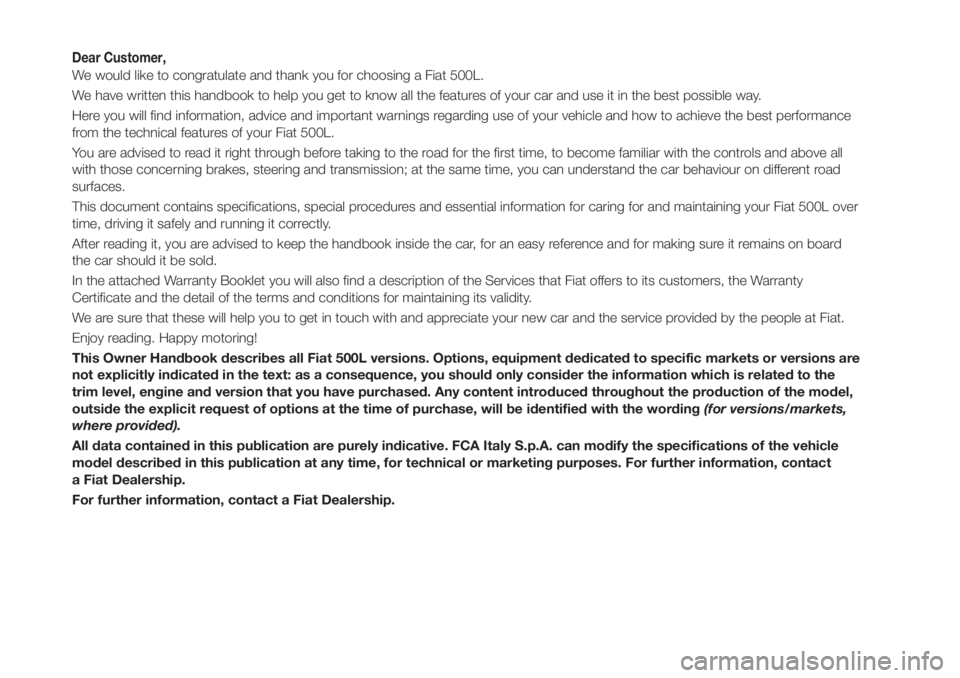
Dear Customer,
We would like to congratulate and thank you for choosing a Fiat 500L.
We have written this handbook to help you get to know all the features of your car and use it in the best possible way.
Here you will find information, advice and important warnings regarding use of your vehicle and how to achieve the best performance
from the technical features of your Fiat 500L.
You are advised to read it right through before taking to the road for the first time, to become familiar with the controls and above all
with those concerning brakes, steering and transmission; at the same time, you can understand the car behaviour on different road
surfaces.
This document contains specifications, special procedures and essential information for caring for and maintaining your Fiat 500L over
time, driving it safely and running it correctly.
After reading it, you are advised to keep the handbook inside the car, for an easy reference and for making sure it remains on board
the car should it be sold.
In the attached Warranty Booklet you will also find a description of the Services that Fiat offers to its customers, the Warranty
Certificate and the detail of the terms and conditions for maintaining its validity.
We are sure that these will help you to get in touch with and appreciate your new car and the service provided by the people at Fiat.
Enjoy reading. Happy motoring!
This Owner Handbook describes all Fiat 500L versions. Options, equipment dedicated to specific markets or versions are
not explicitly indicated in the text: as a consequence, you should only consider the information which is related to the
trim level, engine and version that you have purchased. Any content introduced throughout the production of the model,
outside the explicit request of options at the time of purchase, will be identified with the wording(for versions/markets,
where provided).
All data contained in this publication are purely indicative. FCA Italy S.p.A. can modify the specifications of the vehicle
model described in this publication at any time, for technical or marketing purposes. For further information, contact
a Fiat Dealership.
For further information, contact a Fiat Dealership.
Page 4 of 248
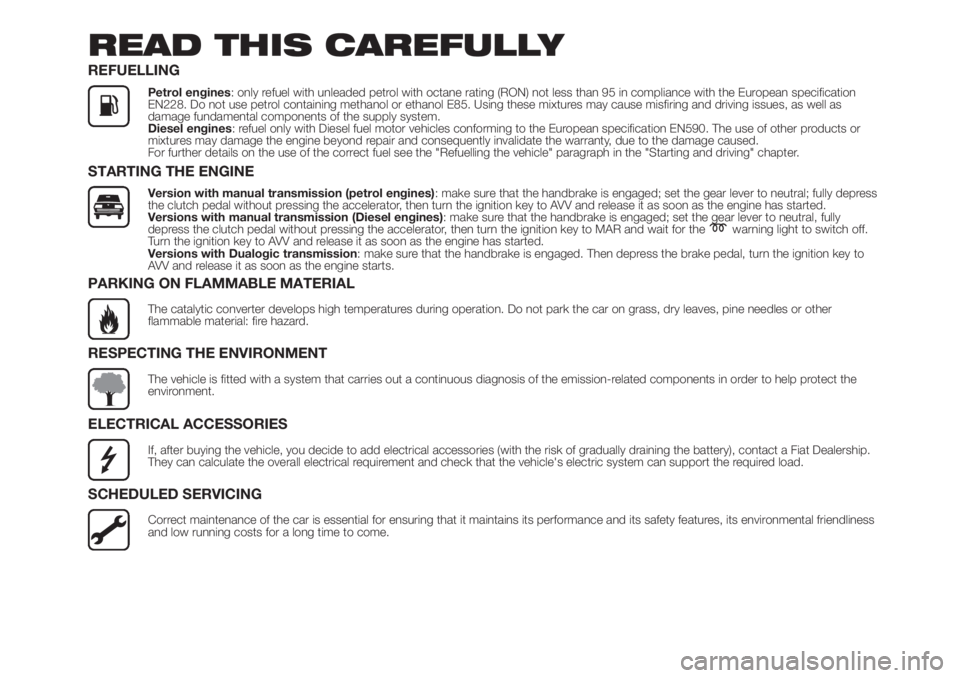
READ THIS CAREFULLY
REFUELLING
Petrol engines: only refuel with unleaded petrol with octane rating (RON) not less than 95 in compliance with the European specification
EN228. Do not use petrol containing methanol or ethanol E85. Using these mixtures may cause misfiring and driving issues, as well as
damage fundamental components of the supply system.
Diesel engines: refuel only with Diesel fuel motor vehicles conforming to the European specification EN590. The use of other products or
mixtures may damage the engine beyond repair and consequently invalidate the warranty, due to the damage caused.
For further details on the use of the correct fuel see the "Refuelling the vehicle" paragraph in the "Starting and driving" chapter.
STARTING THE ENGINE
Version with manual transmission (petrol engines): make sure that the handbrake is engaged; set the gear lever to neutral; fully depress
the clutch pedal without pressing the accelerator, then turn the ignition key to AVV and release it as soon as the engine has started.
Versions with manual transmission (Diesel engines): make sure that the handbrake is engaged; set the gear lever to neutral, fully
depress the clutch pedal without pressing the accelerator, then turn the ignition key to MAR and wait for the
warning light to switch off.
Turn the ignition key to AVV and release it as soon as the engine has started.
Versions with Dualogic transmission: make sure that the handbrake is engaged. Then depress the brake pedal, turn the ignition key to
AVV and release it as soon as the engine starts.
PARKING ON FLAMMABLE MATERIAL
The catalytic converter develops high temperatures during operation. Do not park the car on grass, dry leaves, pine needles or other
flammable material: fire hazard.
RESPECTING THE ENVIRONMENT
The vehicle is fitted with a system that carries out a continuous diagnosis of the emission-related components in order to help protect the
environment.
ELECTRICAL ACCESSORIES
If, after buying the vehicle, you decide to add electrical accessories (with the risk of gradually draining the battery), contact a Fiat Dealership.
They can calculate the overall electrical requirement and check that the vehicle's electric system can support the required load.
SCHEDULED SERVICING
Correct maintenance of the car is essential for ensuring that it maintains its performance and its safety features, its environmental friendliness
and low running costs for a long time to come.
Page 46 of 248
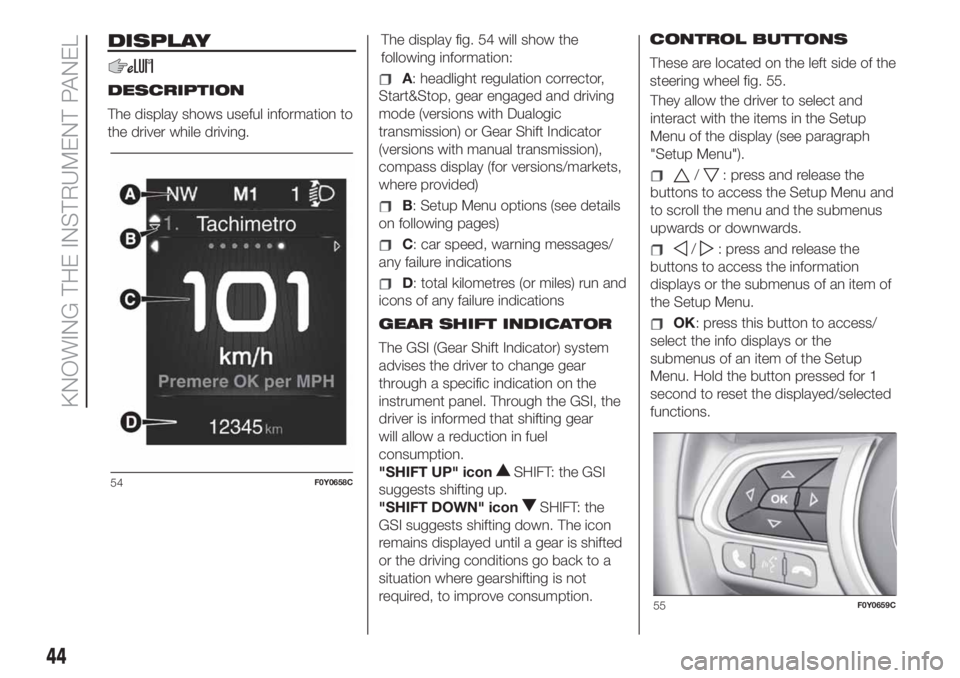
DISPLAY
DESCRIPTION
The display shows useful information to
the driver while driving.The display fig. 54 will show the
following information:A: headlight regulation corrector,
Start&Stop, gear engaged and driving
mode (versions with Dualogic
transmission) or Gear Shift Indicator
(versions with manual transmission),
compass display (for versions/markets,
where provided)
B: Setup Menu options (see details
on following pages)
C: car speed, warning messages/
any failure indications
D: total kilometres (or miles) run and
icons of any failure indications
GEAR SHIFT INDICATOR
The GSI (Gear Shift Indicator) system
advises the driver to change gear
through a specific indication on the
instrument panel. Through the GSI, the
driver is informed that shifting gear
will allow a reduction in fuel
consumption.
"SHIFT UP" icon
SHIFT: the GSI
suggests shifting up.
"SHIFT DOWN" icon
SHIFT: the
GSI suggests shifting down. The icon
remains displayed until a gear is shifted
or the driving conditions go back to a
situation where gearshifting is not
required, to improve consumption.CONTROL BUTTONS
These are located on the left side of the
steering wheel fig. 55.
They allow the driver to select and
interact with the items in the Setup
Menu of the display (see paragraph
"Setup Menu").
/: press and release the
buttons to access the Setup Menu and
to scroll the menu and the submenus
upwards or downwards.
/: press and release the
buttons to access the information
displays or the submenus of an item of
the Setup Menu.
OK: press this button to access/
select the info displays or the
submenus of an item of the Setup
Menu. Hold the button pressed for 1
second to reset the displayed/selected
functions.
54F0Y0658C
55F0Y0659C
44
KNOWING THE INSTRUMENT PANEL
Page 61 of 248
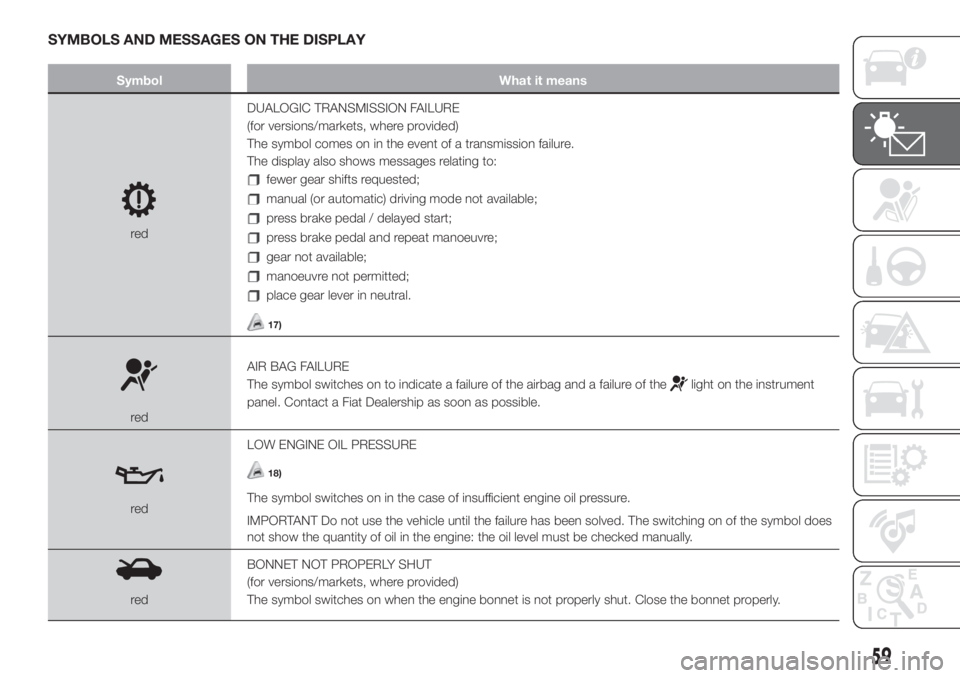
SYMBOLS AND MESSAGES ON THE DISPLAY
Symbol What it means
redDUALOGIC TRANSMISSION FAILURE
(for versions/markets, where provided)
The symbol comes on in the event of a transmission failure.
The display also shows messages relating to:
fewer gear shifts requested;
manual (or automatic) driving mode not available;
press brake pedal / delayed start;
press brake pedal and repeat manoeuvre;
gear not available;
manoeuvre not permitted;
place gear lever in neutral.
17)
redAIR BAG FAILURE
The symbol switches on to indicate a failure of the airbag and a failure of the
light on the instrument
panel. Contact a Fiat Dealership as soon as possible.
redLOW ENGINE OIL PRESSURE
18)
The symbol switches on in the case of insufficient engine oil pressure.
IMPORTANT Do not use the vehicle until the failure has been solved. The switching on of the symbol does
not show the quantity of oil in the engine: the oil level must be checked manually.
redBONNET NOT PROPERLY SHUT
(for versions/markets, where provided)
The symbol switches on when the engine bonnet is not properly shut. Close the bonnet properly.
59
Page 63 of 248
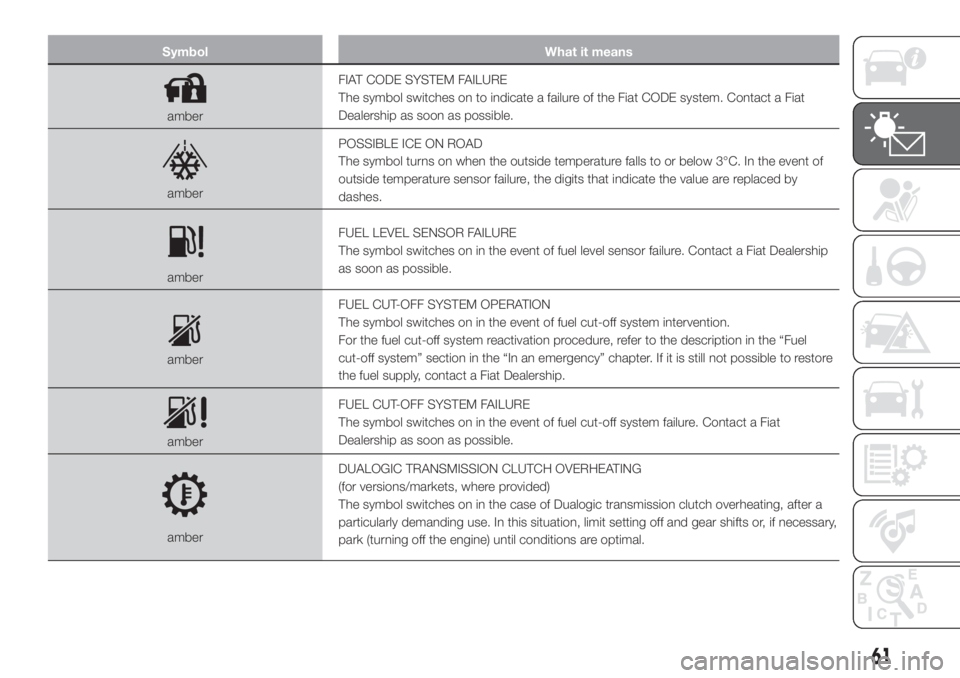
Symbol What it means
amberFIAT CODE SYSTEM FAILURE
The symbol switches on to indicate a failure of the Fiat CODE system. Contact a Fiat
Dealership as soon as possible.
amberPOSSIBLE ICE ON ROAD
The symbol turns on when the outside temperature falls to or below 3°C. In the event of
outside temperature sensor failure, the digits that indicate the value are replaced by
dashes.
amberFUEL LEVEL SENSOR FAILURE
The symbol switches on in the event of fuel level sensor failure. Contact a Fiat Dealership
as soon as possible.
amberFUEL CUT-OFF SYSTEM OPERATION
The symbol switches on in the event of fuel cut-off system intervention.
For the fuel cut-off system reactivation procedure, refer to the description in the “Fuel
cut-off system” section in the “In an emergency” chapter. If it is still not possible to restore
the fuel supply, contact a Fiat Dealership.
amberFUEL CUT-OFF SYSTEM FAILURE
The symbol switches on in the event of fuel cut-off system failure. Contact a Fiat
Dealership as soon as possible.
amberDUALOGIC TRANSMISSION CLUTCH OVERHEATING
(for versions/markets, where provided)
The symbol switches on in the case of Dualogic transmission clutch overheating, after a
particularly demanding use. In this situation, limit setting off and gear shifts or, if necessary,
park (turning off the engine) until conditions are optimal.
61
Page 68 of 248
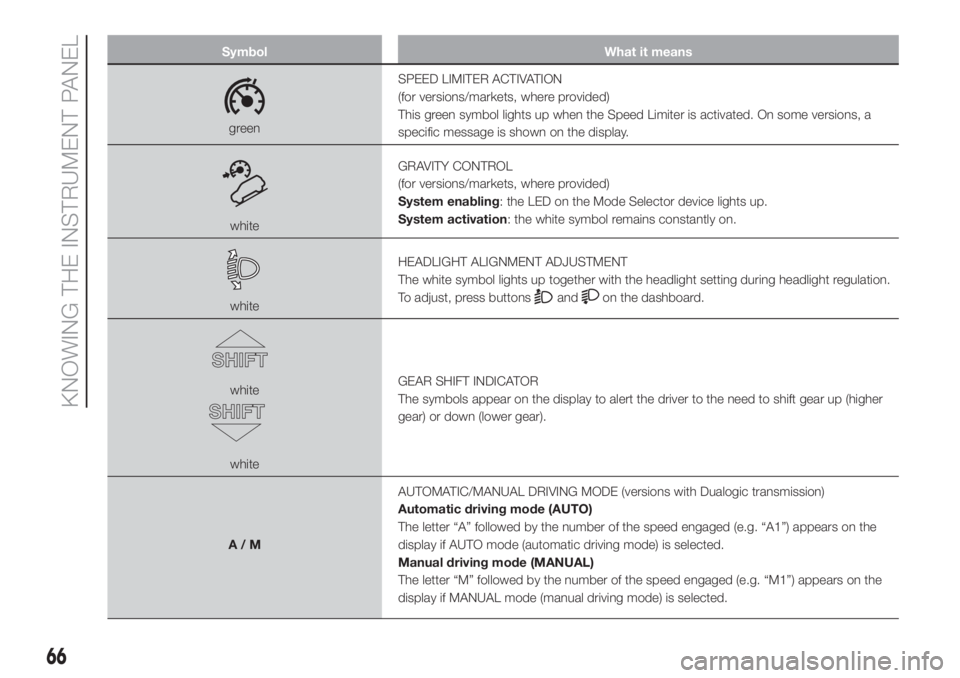
Symbol What it means
greenSPEED LIMITER ACTIVATION
(for versions/markets, where provided)
This green symbol lights up when the Speed Limiter is activated. On some versions, a
specific message is shown on the display.
whiteGRAVITY CONTROL
(for versions/markets, where provided)
System enabling: the LED on the Mode Selector device lights up.
System activation: the white symbol remains constantly on.
whiteHEADLIGHT ALIGNMENT ADJUSTMENT
The white symbol lights up together with the headlight setting during headlight regulation.
To adjust, press buttonsandon the dashboard.
white
whiteGEAR SHIFT INDICATOR
The symbols appear on the display to alert the driver to the need to shift gear up (higher
gear) or down (lower gear).
A/MAUTOMATIC/MANUAL DRIVING MODE (versions with Dualogic transmission)
Automatic driving mode (AUTO)
The letter “A” followed by the number of the speed engaged (e.g. “A1”) appears on the
display if AUTO mode (automatic driving mode) is selected.
Manual driving mode (MANUAL)
The letter “M” followed by the number of the speed engaged (e.g. “M1”) appears on the
display if MANUAL mode (manual driving mode) is selected.
66
KNOWING THE INSTRUMENT PANEL
Page 74 of 248
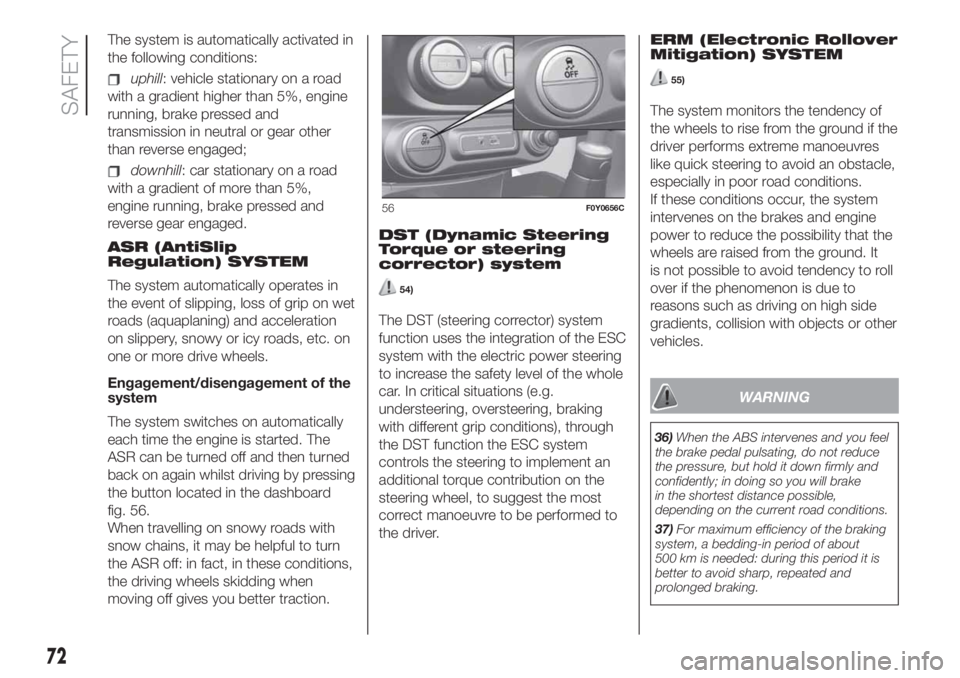
The system is automatically activated in
the following conditions:
uphill: vehicle stationary on a road
with a gradient higher than 5%, engine
running, brake pressed and
transmission in neutral or gear other
than reverse engaged;
downhill: car stationary on a road
with a gradient of more than 5%,
engine running, brake pressed and
reverse gear engaged.
ASR (AntiSlip
Regulation) SYSTEM
The system automatically operates in
the event of slipping, loss of grip on wet
roads (aquaplaning) and acceleration
on slippery, snowy or icy roads, etc. on
one or more drive wheels.
Engagement/disengagement of the
system
The system switches on automatically
each time the engine is started. The
ASR can be turned off and then turned
back on again whilst driving by pressing
the button located in the dashboard
fig. 56.
When travelling on snowy roads with
snow chains, it may be helpful to turn
the ASR off: in fact, in these conditions,
the driving wheels skidding when
moving off gives you better traction.DST (Dynamic Steering
Torque or steering
corrector) system
54)
The DST (steering corrector) system
function uses the integration of the ESC
system with the electric power steering
to increase the safety level of the whole
car. In critical situations (e.g.
understeering, oversteering, braking
with different grip conditions), through
the DST function the ESC system
controls the steering to implement an
additional torque contribution on the
steering wheel, to suggest the most
correct manoeuvre to be performed to
the driver.ERM (Electronic Rollover
Mitigation) SYSTEM
55)
The system monitors the tendency of
the wheels to rise from the ground if the
driver performs extreme manoeuvres
like quick steering to avoid an obstacle,
especially in poor road conditions.
If these conditions occur, the system
intervenes on the brakes and engine
power to reduce the possibility that the
wheels are raised from the ground. It
is not possible to avoid tendency to roll
over if the phenomenon is due to
reasons such as driving on high side
gradients, collision with objects or other
vehicles.
WARNING
36)When the ABS intervenes and you feel
the brake pedal pulsating, do not reduce
the pressure, but hold it down firmly and
confidently; in doing so you will brake
in the shortest distance possible,
depending on the current road conditions.
37)For maximum efficiency of the braking
system, a bedding-in period of about
500 km is needed: during this period it is
better to avoid sharp, repeated and
prolonged braking.
56F0Y0656C
72
SAFETY
Page 76 of 248
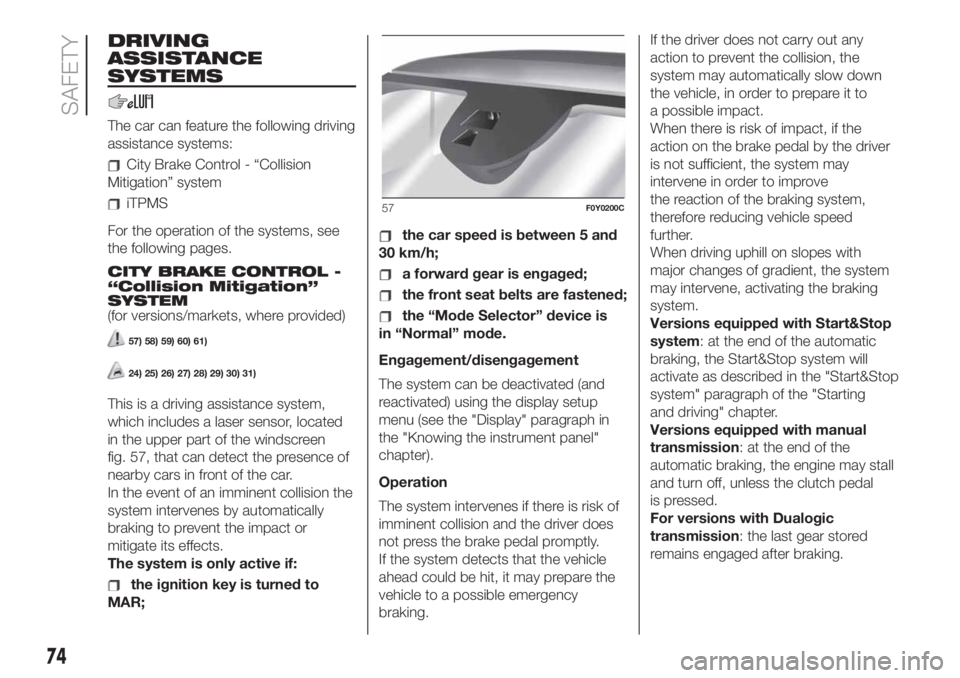
DRIVING
ASSISTANCE
SYSTEMS
The car can feature the following driving
assistance systems:
City Brake Control - “Collision
Mitigation” system
iTPMS
For the operation of the systems, see
the following pages.
CITY BRAKE CONTROL -
“Collision Mitigation”
SYSTEM
(for versions/markets, where provided)
57) 58) 59) 60) 61)
24) 25) 26) 27) 28) 29) 30) 31)
This is a driving assistance system,
which includes a laser sensor, located
in the upper part of the windscreen
fig. 57, that can detect the presence of
nearby cars in front of the car.
In the event of an imminent collision the
system intervenes by automatically
braking to prevent the impact or
mitigate its effects.
The system is only active if:
the ignition key is turned to
MAR;
the car speed is between 5 and
30 km/h;
a forward gear is engaged;
the front seat belts are fastened;
the “Mode Selector” device is
in “Normal” mode.
Engagement/disengagement
The system can be deactivated (and
reactivated) using the display setup
menu (see the "Display" paragraph in
the "Knowing the instrument panel"
chapter).
Operation
The system intervenes if there is risk of
imminent collision and the driver does
not press the brake pedal promptly.
If the system detects that the vehicle
ahead could be hit, it may prepare the
vehicle to a possible emergency
braking.If the driver does not carry out any
action to prevent the collision, the
system may automatically slow down
the vehicle, in order to prepare it to
a possible impact.
When there is risk of impact, if the
action on the brake pedal by the driver
is not sufficient, the system may
intervene in order to improve
the reaction of the braking system,
therefore reducing vehicle speed
further.
When driving uphill on slopes with
major changes of gradient, the system
may intervene, activating the braking
system.
Versions equipped with Start&Stop
system: at the end of the automatic
braking, the Start&Stop system will
activate as described in the "Start&Stop
system" paragraph of the "Starting
and driving" chapter.
Versions equipped with manual
transmission: at the end of the
automatic braking, the engine may stall
and turn off, unless the clutch pedal
is pressed.
For versions with Dualogic
transmission: the last gear stored
remains engaged after braking.
57F0Y0200C
74
SAFETY
Page 104 of 248
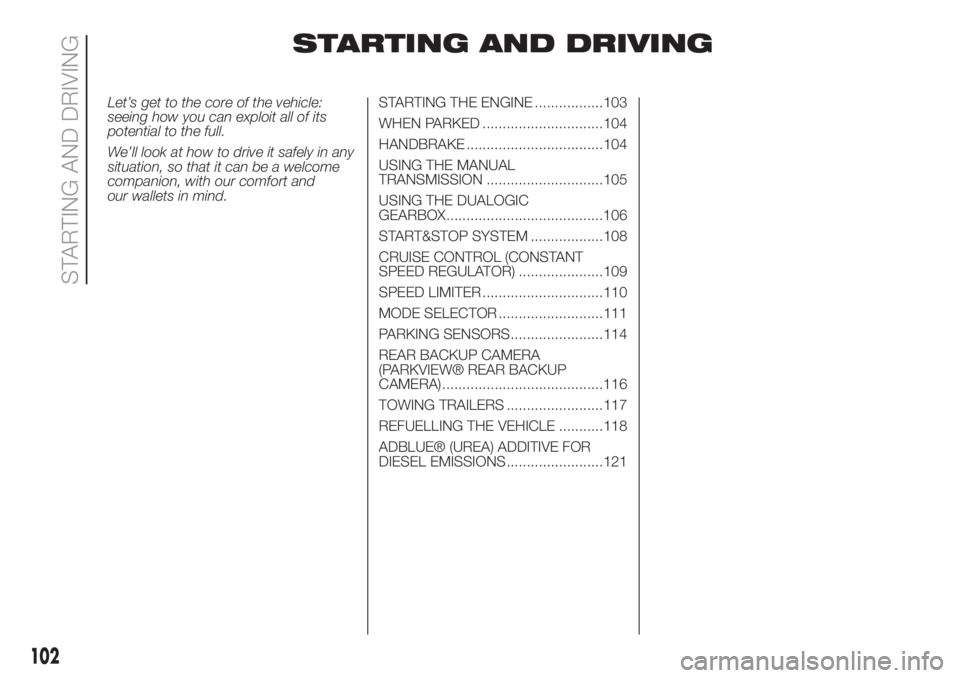
STARTING AND DRIVING
Let’s get to the core of the vehicle:
seeing how you can exploit all of its
potential to the full.
We’ll look at how to drive it safely in any
situation, so that it can be a welcome
companion, with our comfort and
our wallets in mind.STARTING THE ENGINE .................103
WHEN PARKED ..............................104
HANDBRAKE ..................................104
USING THE MANUAL
TRANSMISSION .............................105
USING THE DUALOGIC
GEARBOX.......................................106
START&STOP SYSTEM ..................108
CRUISE CONTROL (CONSTANT
SPEED REGULATOR) .....................109
SPEED LIMITER ..............................110
MODE SELECTOR ..........................111
PARKING SENSORS.......................114
REAR BACKUP CAMERA
(PARKVIEW® REAR BACKUP
CAMERA) ........................................116
TOWING TRAILERS ........................117
REFUELLING THE VEHICLE ...........118
ADBLUE® (UREA) ADDITIVE FOR
DIESEL EMISSIONS ........................121
102
STARTING AND DRIVING
Page 105 of 248
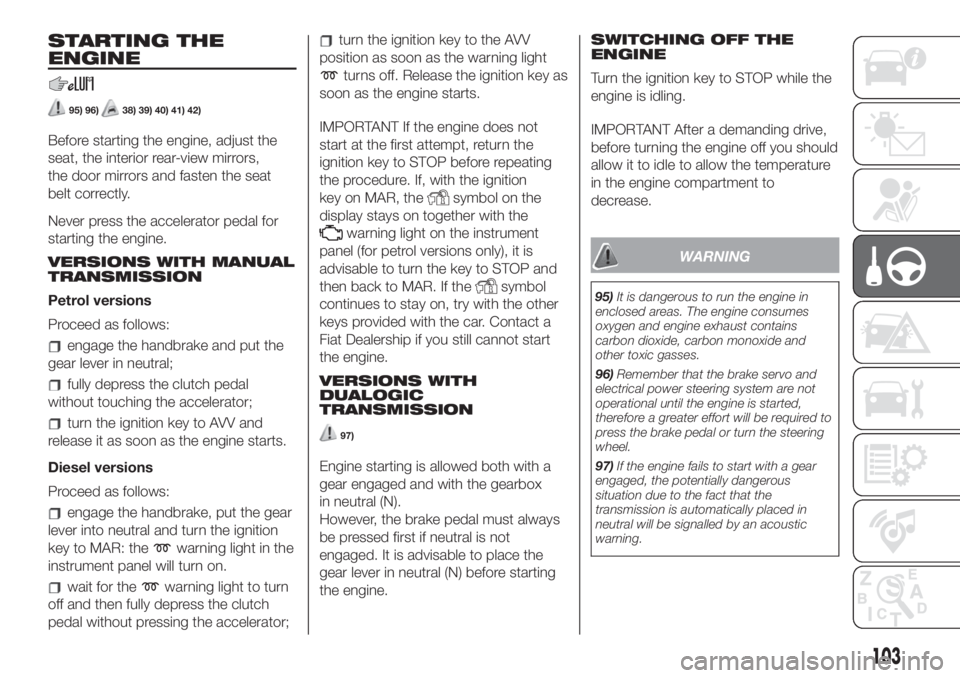
STARTING THE
ENGINE
95) 96)38) 39) 40) 41) 42)
Before starting the engine, adjust the
seat, the interior rear-view mirrors,
the door mirrors and fasten the seat
belt correctly.
Never press the accelerator pedal for
starting the engine.
VERSIONS WITH MANUAL
TRANSMISSION
Petrol versions
Proceed as follows:
engage the handbrake and put the
gear lever in neutral;
fully depress the clutch pedal
without touching the accelerator;
turn the ignition key to AVV and
release it as soon as the engine starts.
Diesel versions
Proceed as follows:
engage the handbrake, put the gear
lever into neutral and turn the ignition
key to MAR: the
warning light in the
instrument panel will turn on.
wait for thewarning light to turn
off and then fully depress the clutch
pedal without pressing the accelerator;
turn the ignition key to the AVV
position as soon as the warning light
turns off. Release the ignition key as
soon as the engine starts.
IMPORTANT If the engine does not
start at the first attempt, return the
ignition key to STOP before repeating
the procedure. If, with the ignition
key on MAR, the
symbol on the
display stays on together with the
warning light on the instrument
panel (for petrol versions only), it is
advisable to turn the key to STOP and
then back to MAR. If the
symbol
continues to stay on, try with the other
keys provided with the car. Contact a
Fiat Dealership if you still cannot start
the engine.
VERSIONS WITH
DUALOGIC
TRANSMISSION
97)
Engine starting is allowed both with a
gear engaged and with the gearbox
in neutral (N).
However, the brake pedal must always
be pressed first if neutral is not
engaged. It is advisable to place the
gear lever in neutral (N) before starting
the engine.SWITCHING OFF THE
ENGINE
Turn the ignition key to STOP while the
engine is idling.
IMPORTANT After a demanding drive,
before turning the engine off you should
allow it to idle to allow the temperature
in the engine compartment to
decrease.
WARNING
95)It is dangerous to run the engine in
enclosed areas. The engine consumes
oxygen and engine exhaust contains
carbon dioxide, carbon monoxide and
other toxic gasses.
96)Remember that the brake servo and
electrical power steering system are not
operational until the engine is started,
therefore a greater effort will be required to
press the brake pedal or turn the steering
wheel.
97)If the engine fails to start with a gear
engaged, the potentially dangerous
situation due to the fact that the
transmission is automatically placed in
neutral will be signalled by an acoustic
warning.
103